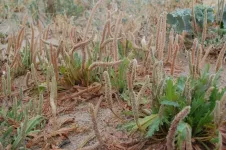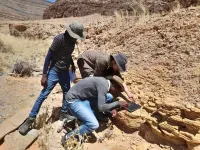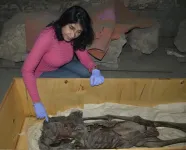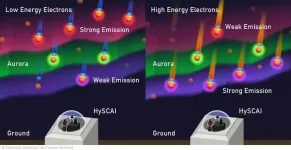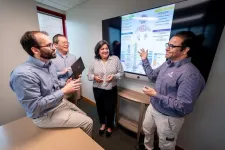(Press-News.org) Scientists have developed a new, safe and effective way to infect volunteers with the parasite that causes leishmaniasis and measure the body’s immune response, bringing a vaccine for the neglected tropical disease a step closer.
The breakthrough, by a team from the University of York and Hull York Medical School, is described in the journal Nature Medicine and lays the foundations for vaccine development and for testing new preventative measures.
Controlled human infection studies, where volunteers are exposed to small amounts of the microbes that cause disease, play a vital role in allowing scientists to provide evidence of the safety and efficacy of new vaccines, but their use in the fight against neglected tropical diseases has been limited.
Leishmaniasis is caused by infection with microscopic Leishmania parasites that are transmitted into the skin during the bite of an infected sand fly.
The disease affects over one million people every year, the majority developing a slow to heal ulcer at the site of the infection. Though the ulcer eventually heals, the scar has a significant impact on quality of life, especially for women and children and when the infection is on the face.
No vaccines or drugs are currently available to prevent people from becoming infected with leishmaniasis, in part due to the difficulties and costs associated with conducting clinical trials in the countries where these diseases are most common.
Lead investigator, Professor Paul Kaye from the Hull York Medical School at the University of York, said: “This is a landmark study that now provides a new approach to test vaccines and preventative measures for leishmaniasis in a rapid and cost-effective way. It also allows us to learn more about how our immune system fights the infection. Thanks to the generosity of the volunteers that took part in our study, we are now well-positioned to bring new hope to those that are affected by this disease.”
Clinical lead for the study, Professor Alison Layton from the Medical School’s Centre for Skin Research, said: “Research on skin diseases that affect people in the UK and in developing countries is a priority at the Medical School. This study, which demonstrates that this infection model is safe and well tolerated by participants, exemplifies our global approach to skin health and has the potential to impact the lives of many millions worldwide.”
The study, which builds on significant achievements by the University of York and its international partners, involved 14 volunteers recruited from around York.
The volunteers were exposed to sand flies infected with a parasite species that causes one of the mildest forms of leishmaniasis. The researchers followed the development of the lesion at the site of the sand fly bite to evaluate the progress of the infection and then terminated the infection by biopsy of the skin. The scientists then studied the biopsy to examine the immune responses at the site of infection.
This major new approach uses natural transmission by sand fly to initiate infection and state of the art technologies, allowing the researchers to track the infection and the body’s immune response in real-time.
The model will accelerate efforts to test new vaccines and understand how immunity to infection arises, the researchers say.
The researchers now hope to use their model to design clinical trials to test a vaccine developed at Hull York Medical School, along with other candidate vaccines available in the future. Controlled human infection models have already been used to support the development of vaccines for cholera, malaria, influenza, dengue fever and most recently COVID-19.
Parkash et al, Safety and reactogenicity of a controlled human infection model of sand fly-transmitted cutaneous leishmaniasis is published in the journal Nature Medicine.
The research was a collaboration between the Hull York Medical School, York and Scarborough Teaching Hospitals NHS Trust, the Department of Parasitology at Charles University in Prague, the Center for Geographic Medicine and Tropical Diseases at Chaim Sheba Medical Center, Tel Aviv University and the Kuvin Centre for Study of Tropical & Infectious Diseases, Hebrew University-Hadassah Medical School, Jerusalem.
Funding for the research was through a Developmental Pathways Funding Scheme award from the UK Medical Research Council (MRC) and the UK Department for International Development (DFID) under the MRC/DFID Concordat agreement and is also part of the EDCTP2 program supported by the European Union.
END
York researchers make breakthrough in bid to develop vaccines and drugs for neglected tropical disease
Scientists have developed a new, safe and effective way to infect volunteers with the parasite that causes leishmaniasis and measure the body’s immune response, bringing a vaccine for the neglected tropical disease a step closer.
2024-08-02
ELSE PRESS RELEASES FROM THIS DATE:
Combined effects of plastic pollution and seawater flooding amplify threats to coastal plant species
2024-08-02
Two of the planet’s more pressing environmental stressors have the potential to alter the growth and reproductive output of plants found right along the world’s coastlines, a new study suggests.
The research, published in the journal Environmental Pollution, is one of the first to examine the combined effects of seawater flooding and microplastic pollution on coastal plants.
It showed that both stressors had some effects on the species tested, with microplastics impacting the plants’ reproduction while flooding caused greater tissue death.
However, being exposed to both microplastics ...
Sea level changes shaped early life on Earth, fossil study reveals
2024-08-02
A newly developed timeline of early animal fossils reveals a link between sea levels, changes in marine oxygen, and the appearance of the earliest ancestors of present-day animals.
The study reveals clues into the forces that drove the evolution of the earliest organisms, from which all major animal groups descended.
A team from the University of Edinburgh studied a compilation of rocks and fossils from the so-called Ediacaran-Cambrian interval – a slice of time 580–510 million years ago. This period witnessed an explosion of biodiversity according to fossil records, the causes of which have ...
'Screaming Woman' mummy may have died in agony 3,500 years ago
2024-08-02
In 1935, the Metropolitan Museum of New York led an archaeological expedition to Egypt. In Deir Elbahari near Luxor, the site of ancient Thebes, they excavated the tomb of Senmut, the architect and overseer of royal works – and reputedly, lover – of the famed queen Hatschepsut (1479-1458 BCE). Beneath Senmut's tomb, they found a separate burial chamber for his mother Hat-Nufer and other, unidentified relatives.
Here, they made an uncanny discovery: a wooden coffin holding the mummy of an elderly woman, wearing a black wig and two scarab rings in silver and gold. But what struck the archaeologists was the ...
Healthy AI: Sustainable artificial intelligence for healthcare
2024-08-02
Similar to other sectors around the world, the light speed development of artificial intelligence (AI) has made its way into healthcare, particularly the radiology field. As such, AI-based diagnostic systems are flourishing, with hospitals quickly adopting the technology to assist radiologists. In contrast, there are concerns about the environmental impact of increasingly complex AI models and the need for more sustainable AI solutions.
Therefore, Associate Professor Daiju Ueda of Osaka Metropolitan University’s ...
First full 2-D spectral image of aurora borealis from a hyperspectral camera
2024-08-02
Auroras are natural luminous phenomena caused by the interaction of electrons falling from the sky and the upper atmosphere. Most of the observed light consists of emission lines of neutral or ionized nitrogen and oxygen atoms and molecular emission bands, and the color is determined by the transition energy levels, molecular vibrations and rotations. There is a variety of characteristic colors of auroras, such as green and red, but there are multiple theories about the emission process by which they appear in different types of auroras, and to understand the colors of auroras, the light must be broken down. ...
Turkey vultures fly faster to defy thin air
2024-08-02
Mountain hikes are invigorating. Crisp air and clear views can refresh the soul, but thin air presents an additional challenge for high-altitude birds. ‘All else being equal, bird wings produce less lift in low density air’, says Jonathan Rader from the University of North Carolina (UNC) at Chapel Hill, USA, making it more difficult to remain aloft. Yet this doesn’t seem to put them off. Bar-headed geese, cranes and bar-tailed godwits have recorded altitude records of 6000 m and more. So how do they manage to take to the air when thin air offers ...
Texas A&M professor named to Committee on Rural Health by U.S. Secretary of Health and Human Services
2024-08-01
Dr. Alva O. Ferdinand, head of the Department of Health Policy and Management at the Texas A&M University School of Public Health, has been named to the Health Resources and Services Administration’s National Advisory Committee on Rural Health by U.S. Secretary of Health and Human Services Xavier Becerra. She will serve a four-year term on the committee, which is comprised of nationally recognized rural health experts tasked with providing recommendations on rural health issues.
Since 2019, Ferdinand has served as director of the Southwest Rural Health Research Center, whose research has impacted federal policies nationwide for more than two decades. ...
Drug developed for pancreatic cancer shows promise against most aggressive form of medulloblastoma
2024-08-01
A drug that was developed to treat pancreatic cancer has now been shown to increase symptom-free survival in preclinical medulloblastoma models – all without showing signs of toxicity.
Medulloblastoma is the most common malignant brain tumor in children. Survival rates vary according to which one of the four subtypes a patient has, but the worst survival rates, historically at about 40%, are for Group 3, which this research focused on.
Jezabel Rodriguez Blanco, Ph.D., an assistant professor who holds dual appointments at MUSC Hollings Cancer Center and the Darby Children’s ...
Retreat of tropical glaciers foreshadows changing climate's effect on the global ice
2024-08-01
MADISON — As they are in many places around the globe, glaciers perched high in the Andes Mountains are shrinking. Now, researchers at the University of Wisconsin–Madison and their collaborators have uncovered evidence that the high-altitude tropical ice fields are likely smaller than they've been at any time since the last ice age ended 11,700 years ago.
That would make the tropical Andes the first region in the world known to pass that threshold as a result of the steadily warming global climate. It also makes them possible harbingers of what's to come for glaciers globally.
"We think these are the canary ...
St. Jude gene panel for pediatric cancers increases access to high-quality testing
2024-08-01
Scientists at St. Jude Children’s Research Hospital have created a panel that is able to provide a diagnosis for >90% of pediatric cancer patients by sequencing 0.15% of the human genome. The panel is a cost-effective way to test and classify childhood malignancies and to help guide patient treatment. The panel’s performance and validation were published this week in Clinical Cancer Research.
Finding the mutations in a child’s cancer with powerful sequencing technology can lead to better outcomes. Physicians use that knowledge to tailor targeted treatments to the specific cancer-causing mutations affecting each patient. However, current ...
LAST 30 PRESS RELEASES:
Air pollution exposure and birth weight
Obstructive sleep apnea risk and mental health conditions among older adults
How talking slows eye movements behind the wheel
The Ceramic Society of Japan’s Oxoate Ceramics Research Association launches new international book project
Heart-brain connection: international study reveals the role of the vagus nerve in keeping the heart young
Researchers identify Rb1 as a predictive biomarker for a new therapeutic strategy in some breast cancers
Survey reveals ethical gaps slowing AI adoption in pediatric surgery
Stimulant ADHD medications work differently than thought
AI overestimates how smart people are, according to HSE economists
HSE researchers create genome-wide map of quadruplexes
Scientists boost cell "powerhouses" to burn more calories
Automatic label checking: The missing step in making reliable medical AI
Low daily alcohol intake linked to 50% heightened mouth cancer risk in India
American Meteorological Society announces Rick Spinrad as 2026 President-Elect
Biomass-based carbon capture spotlighted in newly released global climate webinar recording
Illuminating invisible nano pollutants: advanced bioimaging tracks the full journey of emerging nanoscale contaminants in living systems
How does age affect recovery from spinal cord injury?
Novel AI tool offers prognosis for patients with head and neck cancer
Fathers’ microplastic exposure tied to their children’s metabolic problems
Research validates laboratory model for studying high-grade serous ovarian cancer
SIR 2026 delivers transformative breakthroughs in minimally invasive medicine to improve patient care
Stem Cell Reports most downloaded papers of 2025 highlight the breadth and impact of stem cell research
Oxford-led study estimates NHS spends around 3% of its primary and secondary care budget on the health impacts of heat and cold in England
A researcher’s long quest leads to a smart composite breakthrough
Urban wild bees act as “microbial sensors” of city health.
New study finds where you live affects recovery after a hip fracture
Forecasting the impact of fully automated vehicle adoption on US road traffic injuries
Alcohol-related hospitalizations from 2016 to 2022
Semaglutide and hospitalizations in patients with obesity and established cardiovascular disease
Researchers ‘listen in’ to embryo-mother interactions during implantation using a culture system replicating the womb lining
[Press-News.org] York researchers make breakthrough in bid to develop vaccines and drugs for neglected tropical diseaseScientists have developed a new, safe and effective way to infect volunteers with the parasite that causes leishmaniasis and measure the body’s immune response, bringing a vaccine for the neglected tropical disease a step closer.
